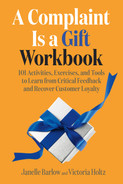Preface
What if we saw complaints as gifts? What if we said “Thank you” whenever we received such a gift? How would the whole field of complaint handling change?
Do you find it hard to handle complaints or destructive feedback that someone has thrown at you? You’re not alone. Most people have difficulty with negative feedback. That’s why we’ve written this workbook, to make complaint handling effortless and pleasing for you and a lot more beneficial to your organization. We wrote this guide so you can see complaints as gifts!
This workbook is a companion to the book A Complaint Is a Gift by Janelle Barlow, which covers some of the same ideas we will go through here. But this workbook is focused on practical techniques— the how-to of complaint handling. It closes the gap between theory and application. This hands-on guide shows how to perform well at one of the most challenging jobs.
Many people assume that all Customer Service Representatives (CSRs) need to be knowledgeable only about the products they represent. They think that since people have been receiving negative feedback throughout their lives, they must know more or less how to handle complaints. That’s not true. Ask CSRs about the most challenging part of complaint handling, and they’ll tell you they can get information about products, but they frequently don’t have any idea how to handle a customer who is irate, is not able to settle down, or threatens to talk with someone higher up in the organization.
This workbook is filled with both fun and challenging activities to handle these difficult situations. To be precise, we’ve included 101 activities! We’re sure you will find at least a few dozen that will work precisely for you, and the rest will let you see the variety of complaints that CSRs receive. This will provide you with multiple options to better interact with complaining customers.
But besides making it possible to get through life without falling apart from negative feedback, why should you care about better complaint handling?
If customers don’t like the way their complaints are handled, one of the easiest ways for them to react is to leave a business. If they don’t personally like the way they were treated, they can let thousands know exactly what happened by going online.
Talking with dissatisfied customers may be the most important communication CSRs have. It’s a chance to improve business by fixing problems. Even more remarkable, if they fix a problem for customers and treat them well, their customers will likely develop stronger loyalty to the business.
It pays to do everything you can to keep customers satisfied and happy—and not only customers but also employees, including you.
Experimenting with complaint-handling techniques will let you choose from various approaches. You’ll become more agile in dealing with different types of customers. You’ll get better at organizing your work around the concept that listening to your customers and encouraging them to speak out when they see something wrong is a good idea. You’ll also learn to pay attention to that critical point in the customer-service process when things go wrong.
We’ll help you fill in gaps in your knowledge so you can carry your new skills into any future work you undertake, whether as an employee or an entrepreneur. As a result, you will no doubt become more customer focused. Everyone will benefit as well: you as a Customer Service Representative, your customers, your team, and your organization.
Our intention here is to step into your life and show how you can provide customer support, love what you do, and learn how to handle difficult customer interactions, or any other type of negative feedback.
